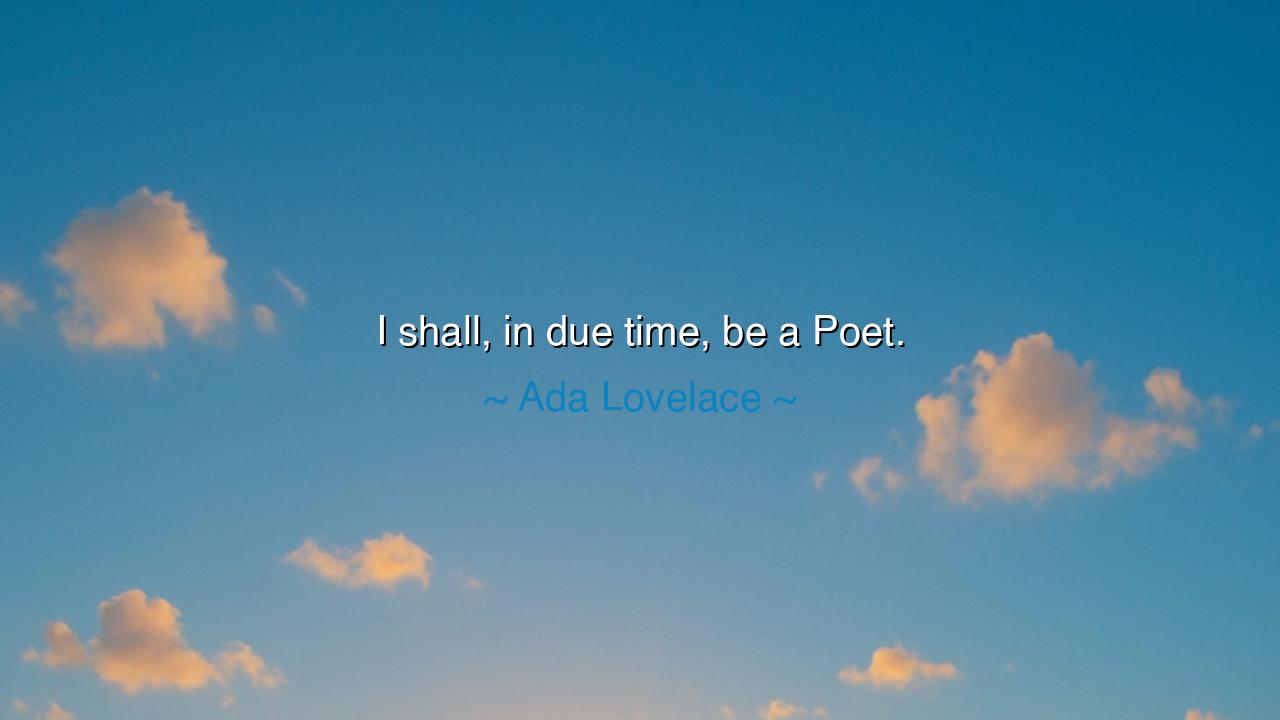
I shall, in due time, be a Poet.






Ada Lovelace, daughter of the tempestuous Lord Byron and heir not only to his blood but also to his restless spirit, once declared with burning certainty: “I shall, in due time, be a Poet.” These words are not the idle boast of youth, nor merely the echo of her father’s fame. They are the prophecy of a soul that understood poetry not only as verse upon parchment, but as vision—the ability to see the invisible, to give voice to the silent, to uncover order within mystery. For in her, numbers themselves became poetry, and through the marriage of mathematics and imagination she gave birth to the world’s first glimpse of computing.
The origin of this declaration lies in her unique inheritance. From her father Byron she carried the fire of imagination, the longing for beauty and the love of language. From her mother, Lady Annabella Milbanke, she received discipline, rigor, and the chains of logic. Ada herself became the union of these opposites—dreamer and analyst, visionary and scientist. Thus, when she proclaimed that she would become a Poet, she did not mean merely one who rhymes, but one who shapes new worlds. Her “poetry” would not be measured in stanzas, but in algorithms; not in meter, but in the rhythm of reason illuminated by imagination.
To be a Poet in Ada’s sense is to stand at the threshold between what is and what could be. Just as Homer sang the deeds of gods and heroes, she sang the future of machines. She saw in Charles Babbage’s Analytical Engine not just a calculating device, but a loom upon which the patterns of the universe itself could be woven. She foresaw that such engines might compose music, generate art, and amplify thought. This vision, dismissed by many of her time, has since unfolded into the digital age in which we now dwell. She spoke as a poet of possibility, giving words to truths the world had not yet dared to imagine.
History offers us kindred spirits. Consider Leonardo da Vinci, who painted like an artist yet invented like a scientist. He, too, was a Poet in the ancient sense—one who fuses imagination with knowledge. Or think of Albert Einstein, who described his theories not only with equations but with metaphors of light, space, and time. Each of these figures reminds us of Ada’s truth: that poetry is not confined to ink and parchment, but is the act of creation itself, the shaping of vision into form.
Thus, Ada’s declaration is more than personal ambition—it is a summons to all who dare to unite art and science, logic and imagination. To say “I shall be a Poet” is to vow that one’s life will be an act of creation, that one’s very work will sing. It is to promise that what one builds will not be dull machinery, but living metaphor, a bridge from the present into the future. In her words lies a challenge: do not settle for half of yourself. Do not bury your imagination for the sake of order, nor abandon reason for the sake of dreams. Unite them, and in due time, you too shall be a Poet.
The lesson for us is clear. Each of us is born with fragments of fire—reason in one hand, imagination in the other. Too often we are told to choose: to be practical or to be a dreamer, to serve science or to serve art. Ada shows us that the truest path is to hold both, to weave them together into a new creation. For every formula may be a poem, every invention a stanza, every vision a verse in the great epic of human progress.
Therefore, let us live as Ada lived—bold in vision, steadfast in labor, and unafraid to claim the title of Poet in whatever form it may take. If you are an engineer, let your machines sing. If you are an artist, let your craft be precise as geometry. If you are a teacher, let your lessons weave wonder as well as truth. And above all, declare with her courage: “I shall, in due time, be a Poet.” For when you shape life itself into creation, you fulfill her prophecy—and your own.






AAdministratorAdministrator
Welcome, honored guests. Please leave a comment, we will respond soon